Trees and Woodland
by Greg Howes
Introduction
As a family historian with roots in the Towy Valley, I have always had a deep interest in the history of the landscape as well as the people within it. The history of the landscape is the history of man, and the history of man embellished within the landscape. Inside that landscape there are few things more dramatic, inspiring and culturally revealing than its trees and woodlands.
Carmarthenshire has many areas of arboreal delights, and none more so than the area around the town of Llandeilo. The Dinefwr estate, Gelli Aur and Tre-gib woods, to name but a few. The cultural uses of trees and woodland have changed over time, but the awe and wonder inspired by them have not. Here is a series of notes on the history of and uses of these natural wonders.
What has Rome ever done for us?
When the Romans came to Carmarthenshire they built forts at Carmarthen and Llandeilo to name just two. The roads they laid down are still visible from the air in some places. They brought about many changes to everyday life, but they also made sweeping changes to the local environment. One of these alterations was to clear great swathes of woodland along roads and byways in order to make attack through ambush by the pre Roman Britons a less likely occurrence. The Romans would have used the timber for drying crops such as corn, bridge building and boat making. Oak was the favoured tree for the Roman fortress and house building, for not only is it tough, but its heartwood is strong and insect damage is minimal.
Middle Age Crisis
The 13th century was one of the most turbulent in Welsh history, and the environs surrounding Llandeilo were no different. In the year 1257 we find evidence from the Talley monks of a large battle being fought in the Towy valley. The battle was fought in an ancient, and now lost wood, of Coed Lathen (Coed Llangathen). The monks tell us of "daybreak till noon the battle was carried on in deep woods" and of soldiers cut down "in the Jungles, the ditches and the dingels"1. This type of evidence gives us vital clues when researching the extent of Llandeilo's arboreal history at this period of time, the extent of woodland, and ongoing use by the native Welsh in using woodlands and forests for battle sites. This proved to be a real thorn in the side of the authorities, so much so, that more clearances were encouraged. In 1284, "The burgesses of Carmarthen were granted free common in the woods, and were permitted to fell and carry away underwood, oaks for timber, and other trees, without any let or hindrance, as a matter of deliberate policy to clear dense woods where robberies and murders where frequent"2. Unsurprisingly, this led to more trouble and Rhys ap Maredudd, a Lord in the Towy valley decided to revolt against such measures. Interestingly, when we are told about this event, it is revealed that, "This rising was suppressed by forces that included very large numbers of woodmen.3
Ships for the Navy
Oaks were used in building ships for Britain's coastal defences and kept up the tradition of felling timber for military purposes within the Towy Valley. In the mid 18th century and again in the time of the Napoleonic wars with France, many thousands of oaks were cut down and stacked up along the banks of the Towy River. When flooding came to the valley, the trunks were pushed into the Towy and guided with the help of local coracle men to Carmarthen, and from this busy sea port they were transported to ship makers around Britain.
Oak for tannin etc
Tannin for hides to make leather was one of the heaviest uses of the oak tree. The oak bark was harvested from coppices every 25 years in site rotations. Latterly bark became available as a by-product of the timber trade. Spring was thought to be the best time for stripping the trunk bare of the bark. Large quantities of bark were shipped out on boats from Carmarthen quay. Welsh-grown oaks grown on hillsides were highly sought after because it was thought that they had very high tannin content. Not all of the oak bark left the county though; much was used in tanneries throughout the length and breadth of Carmarthenshire. Wood was also used as the major source of fuel in lime kilns around the Llandeilo area but was replaced by anthracite coal around 1800.
Notes on ancient Trees and Woodlands
The late 18th century saw the greatest recorded deforestation of Carmarthenshire (and much of Britain), when whole woodlands were lost and some were never replanted again. However, despite this decimation, Carmarthenshire has kept a large area of smaller woods and some notable larger ones on local estates. Many of the smaller woods occupy steep valleys (cwms) and are in a semi-wild condition, which is often teeming with wildlife. Some of these woodlands are classed as "Ancient Woodlands". Tthis term is used when describing woodland which is known to be in existence before 1700, the time just before major industrial felling.
Carmarthenshire has an above average amount of woodland and about one fifth of the county's woods are thought to be on a site of ancient woodland. Though we must always be aware when searching for evidence of ancient woodland the term "Forest" did not have the meaning that we place on it today. Legally speaking "a forest was an area of roughland on which the king or some other magnate had the right to keep deer and to kill and eat them".4 Ancient woodland sites around Llandeilo can be indicated and found in many different ways, place-name elements are one such example.
- Allot
- Wooded hillside
- Bedwos, Bedwes
- Birch Grove
- Carw
- Stag or deer
- Coed
- Wood
- Coetref
- Woodland homestead or farmstead
- Collwyn
- Hazel-wood
- Derlwyn
- Oak grove
- Derwen
- Oak tree
- Derwydd
- Druid
- Drean
- Thorn
- Garth
- Wooded slope
- Gelli
- Grove
- Gwern
- Alder or marshy land, Swamp
- Gwernos
- Place where Alder trees grow
- Gwig
- Wood
- Gwinllan
- Orchard or grove
- Helyg
- Willows
- Llwyn
- Grove
- Nyfed
- Grove or Sanctuary
- Perllan
- Orchard
- Perth
- Wood, forest
- Pren
- Tree
- Prysg
- Brushwood, thicket, copse
Remnants of ancient woodland around the Llandeilo area can be present in ditches and borders between old parishes and estates. The importance of old trees as markers and borders cannot be overlooked; it is a system used for well over a thousand years. Indeed it is possible that what Oliver Rackham described as "ghost woods " exist as remnants in our hedges as markers and borders which were once woodland fringes left as hedges when the wood was felled. While studying the 1887 and 1906 ordnance survey maps around the Llandeilo area I found evidence of many different tree species noted for either field or parish boundaries: Cherry, Beech, Willow, Oak White thorn, Birch, Ash, Apple. I even found an alder stump mentioned, and vaguer still, one location just said stump. The place name Broad Oak in the Towy valley is named after an actual (ancient?) oak marked on the cross roads that was featured on Ogilby's Brittania map in 1675.
Ancient woodland has a greater diversity of plant, animal and fungi species, some of which can only be found on these specific sites. Carmarthenshire had 22,919 acres of woodland in 1913, 5,473 coppice acres, 1,546 plantations under 10 years old, 15,900 described as "other woodland"5, which was around 4% of the total acreage of Carmarthenshire.
Footnotes
- Lewis Anne, BA, The last siege of Dryslwyn Castle.
- Linnard, William, "Welsh Woods and forests, A History", page 32, published by Gomer, in the year 2000.
- Linnard, William, "Welsh Woods and forests, A History", page 32, published by Gomer, in the year 2000.
- Rackham, Oliver "The last forest", Published by Dent, in 1993.
- Linnard, William, "Welsh Woods and forests, A History", page 183, published by Gomer, in the year 2000.
Gelli Aur Country Park and Arboretum
As a hunter of veteran and champion trees, two sites stick out more than most; the first is Gelli Aur (Golden Grove), which is situated on the South side of the Towy, three miles west of Llandeilo. On approaching the site there is a splendid avenue of Limes (Tilias) thought to have been planted before 1860.The country deer park on the north part of the site has many veteran oaks, and other large trees of interest.
The site is home to a large manor house once occupied by the Vaughans, who were great planters and guardians of their trees. As early as 1608, Sir William Vaughan (1577-1641), the agricultural and colonial pioneer, had advocated the planting of trees and the making of orchards among his methods for improving agriculture1. John Vaughan carried on this tradition by purchasing 5000 saplings from a London nursery in 1781, which included:
- 600 Weymouth Pines
- 600 Spruce Firs
- 200 Silver Firs
- 500 Common Larch
- 600 Portugal Laurels
- 300 Common Alaternus
- 24 Cedars of Lebanon
- 24 Hemlock Spruce Firs
- 400 Lime trees
- 24 Alexandria Laurels
- 200 New White Broom
- 400 Common Laurels
- 150 Fine Red Virginian Cedars, as well as Scotch Fir, Spanish Chestnut, Beech, etc 2.
Another strong-willed champion of the trees was Lady Anne Vaughan who doggedly refused to have her beloved trees cut down, and ruin her ancestral seat despite desperate pleas from here penny-pinching husband Lord Winchester. These ancestral homes often cherished their trees for generations, and the grounds were a reflection of the family's high standing and long-standing link with the locality.
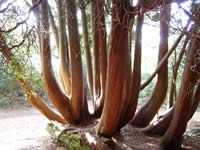
The real jewel in the crown of Gelli Aur, in my opinion, is the Arboretum, which is open to the public seven days a week and is free of charge except for parking .The Arboretum is thought to have been planted in the 1860s and according to one source the Western red cedar (Thuja plicata) was planted in 1863, Western hemlock (Tsuga heterophylla) planted in 1866 and two Hiba (Thujopsis dolabrata) in 1869.
The arboretum was superimposed over an existing parkland site, which already had some large veteran sweet chestnuts, and oaks. The sweet chestnuts on the terrace can be abundant in their nut production and many have notable girths, two in particular. One measures 6.09 metres the other 5.37 metres. The arboretum has a great deal of charm and interest for young and old alike. One of the fascinating things about this arboretum is not only the size of its trees, but the occurrences of bundle planting which produces multi-stemmed giants. These give Gelli Aur arboretum a real sense of grandeur, style and uniqueness all of its own.
The arboretum has a fantastic selection of specimen trees from around the globe. But for me it's mature specimens that win the day. It can boast some nationally verified champions: the Fern leaved Beech (Fagus sylvatica "Heterophylla") has the widest girth registered in Britain for this species, as does the yellow Juniper (Juniperus chinensis "Aurea"). Other top national trees of note are the Sawara cypress, (Chamaecyparis pisifera) Swamp cypress (Taxodium Distinctum) and Cryptomeria japonica elegans.
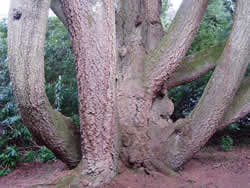
The multi-stemmed monsters for me are the most impressive. Monterey pine (Pinus radiata) and the huge Douglas fir (Pseudotsuga menziesii) are just some of the arboreal delights offered by this unique collection. Incidentally I would like to add a special note about the man who first introduced the Douglas fir, David Douglas, who despite his lowly birth was one of the great botanical pioneers of the early 19th century, and braved just about every discomfort known to man in order to bring back viable trees from across the globe. Just outside the arboretum is the famous Gelli Aur oak, which unfortunately has shown no evidence of life for over two years This massive hulk is thought to be approximately 1000 years old. The old oak is still majestic in its decline and is the host for a huge range of other life forms. Root compression by forestry vehicles is thought to have finally ended the last chapter in this old warrior's life.
Footnotes
- Hughes Lynn, "A Carmarthen Anthology" page 378 published by Dinefwr Publishers, Llandybie, 2002.
- Linnard, William, "Welsh Woods and forests, A History", page 145, published by Gomer, in 2000.
Related links:
Dinefwr Park
The other site of major arboreal interest is Dinefwr Country Park, situated on the edge of Llandeilo town, which overlooks the Towy River. The country park itself is only open from April to October, but some of its public footpaths are open all year. This site has many areas to interest the general public It was, according to legend, the site of Rhodri Mawr's castle, who was king of Wales in 877, and the site has Roman connections as well. The site is owned now by the National Trust and has a former stately home in Newton Hall, white cattle and a deer park within its grounds. The site also boasts a 12th century castle with panoramic views of the Towy Valley. When mentioning Dinefwr in the 12th Century Gerald of Wales noted, "Dinefwr is where the royal Place of South Wales used to be; it is well protected by its site and surrounded by woods".
There are some exotic conifer plantings probably stemming from the mid-Victorian craze for unusual specimen trees. These prized exotics often arrived very shortly after their discovery by European plant hunters. There are seven massive Wellingtonias (Sequoiadendron giganteum) on site, the narrowest of which is 5 metres 80cm when measured at 1.5 metres. In their native Sierra Nevada home they can grow to heights of 300ft and live up to 3,000 to 4,000 years old, so our Carmarthenshire giants are hardly approaching adolescence yet.
The common name used for this tree (which is the world's bulkiest tree) is "Wellingtonia" and derives from a nurseryman's sales gimmick. The Duke of Wellington had died in 1852, and the tree was discovered by plant hunter William Lobb in California in 1853. It was decided to replace one giant with another one in the public's consciousness. It certainly worked and the Wellingtonias were a "must have" for any stately home or botanical park and replaced the "Cedar of the Lebanon" as the arboreal giant to grace their local piles. It is no surprise we find other specimens of these impressive trees with similar girths- at Gelli Aur, Arboretum, Tregib school, Ffairfach (also the home to one of the largest horse chestnut trees in Wales), and Pant Glas Hall. These trees grow very well in the damp Carmarthenshire climate, and were native to Britain in the Cretaceous period as seen in fossil evidence. These trees are a haven for the bird named the "Tree Creeper" of which Carmarthenshire has many. It also houses many insects and has a spongy fire-resistant bark, which is up to two feet thick in larger specimens.
Other evidence of this relatively new zest for exotic trees comes in the 1858 book "Llandeilo-Vawr and its neighbourhood" written by William Davies (Gwilym Teilo) where he mentions (when talking of exotic trees) "Many new varieties have lately been introduced into Dynevor and Golden Grove Parks"1, The book also mentions a tulip tree, or trees, present, some Carex and Medlar, as well as more common parkland trees of the day.
Capability Brown visited Dinefwr the in 1775, and probably had an influence over some of the planting scheme, though apart from the clumps of beech, it is difficult to ascertain just how great an influence he had over tree planting and the landscape.
Sir Richard Colt Hoare described Dinefwr woods in the 1790s and said that the oaks had been" perservered with a parent eye from the axe and must therefore, be reasonably ancient. There are quite a few Scots pine (Pinus sylvestris) dotted around the site, one with a girth of 2 metres 40cms.
The Pine Legend
There is an interesting legend surrounding the planting of Scots pine. According to legend they were planted as a show of support or in remembrance of the final Jacobean revolt headed by Bonnie Prince Charlie in 1745. That apparently is how they came by the nickname "Charley trees", and it is interesting to note that Lord Dinefwr in his book on the trees of Dinefwr estate (Spurrel 1934) reckoned the Scots pine on his estate were planted in 1745; whether he had evidence for this, or was just influenced by the legend it is difficult to say.
Wildlife of the Oaks
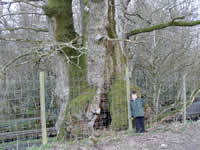
The magnificent oaks of Dinefwr's woods and deer park are a haven for a huge array of diverse wild life. There are many stately veteran and ancient oaks here of tremendous size. The girth of the largest oak ("the Castle Oak") on site has a rather noble girth of 1.5 metres (5 feet) and a height, of 8 metres 68 cms; experts estimate the approximate planting date of 1170. Many other pedunculate oaks have a girth of at least 6 metres. The largest ash tree (Fraxinus excelsior) has a girth of 6 metres 24cms, with an estimated planting date around the 1520s. An exceptional feature of these medieval plantings is the amount of maiden oaks in the park, particularly in the "Heronry", (maiden being a term used for a tree that has not been coppiced or pollarded in its life). The oaks in the Heronry provoked William Davies to write "What a splendid Heronry! See the height of those oak trees, some of them about 70 feet high." 2
Many of the rest of Britain's ancient oaks have survived because of crown reduction, but here at Dinefwr this is not the case. I think the Dinefwr nobles do seem to have regarded Woodland, certainly their timber trees, as a reflection of their wealth and status within the locality, much the same as Gelli Aur.
Large tree and woodlands have a special place in the psyche of local wealthy landowners, whether this springs from a distant memory of sanctuary in the protection of trees, or perhaps woodland represents self sufficiency in the shape of fuel in a wet climate, or indeed some sort of an insurance policy should their dealings with the outside world go pear shaped. Whatever the reason or reasons we should be thankful for this.
Of course these trees have exceptional aesthetic properties and are highly inspirational to the spirit, but on a more environmental front these ancient and veteran trees, of which there are nearly three hundred standing at Dinefwr, provide a home for a myriad of insects, some of which are rare. Also they are homes to a vast number of lichen species, which have a European and national importance, as being a natural indicator of air pollution. The veteran Oaks not only provide a wealth of habitat for other life when they are alive but they also dutifully fit this role when they are in decay.
Useful Fungi
One of the chief reasons Dinefwr is a site of specific scientific importance is its wide range of insect species which survives almost solely on deadwood. These areas of decaying timber furnish a rich environment for rare species of beetles and other insects. These decaying branches and tree trunks provide a vital haven for many species that would certainly stand no chance in our obsessively "tidy" gardens and parks. The ancient and veteran trees have some species of fungi that first colonized the tree centuries ago and can be useful indicators in showing the historical uses of the area and the land around it. These fungi would perhaps find it impossible to propagate themselves locally now due to the changes that have occurred around them.
Some species of fungi can causes heart rot on trees and can persist in their campaign for hundreds of years. This causes what is known as red wood decay and is found mainly on old broadleaf trees. This rot, though, actually enables an old tree to withstand the slings and arrows of the fickle weather, because this rot actually lightens the tree. Another feature of heart rot is that it is less likely to fall in on itself and the accompanying "skin" formed around this rot is actually very tough indeed. Oak heartwood suffering with beefsteak fungus (Fistulina hepatica, in particular can make a special veneer, which is very expensive indeed and much sought after.
Many of the fungal habitats have co-existed and co-evolved with these old trees, and provide a vital link in the recycling of nutrients back into the soils. They have a symbiotic (helping each other out) relationship with each other. This type of fungi is called Mycorrhizae fungi, and has this wonderful ability to share and transport nutrients around vast areas, acting as transformers along the way. Their interaction with trees helps to feed the tree by making it possible for the tree to gain access to nutrients far further than their roots alone could ever do. The fungi gain sugars from the plant's leaves, and the Mycorrhizae actually protect the plant from disease.
It is thought Mycorrhizae actually link up different trees in a complex underground web. In this web like tangle of hyphae; they set about helping out the trees by transferring nutrients and water from one tree to another.
Footnotes
- Davies, William, "Llandeilo-Vawr and its neighborhood"; page 161, Printed by D.W. &G. Jones, Rhosmaen Street. 1858
- Davies, William, "Llandeilo-Vawr and its neighbourhood"; page 134, Printed by D.W. &G. Jones, Rhosmaen Street, 1858.
Related links:
Other trees of note
The impressive yew arch, at Aberglasney gardens, near Llandeilo, has caused much controversy because of the varying interpretations of its age. The arch has been reckoned to be 250 years old by a visit from a dendrochronologist, but other more romantically inclined people have suggested it to be up to 1,000 years old. The arch caused further controversy, because of its recent pruning back, which seems to have split the botanical world as to worth. Aberglasney is also the home of one of the largest weeping ash trees in Wales, which was noted as being mature in the 1870s.
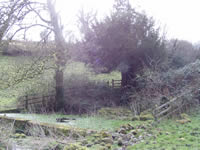
The "Holy Well" and yew tree at the source of the Gwenlais River near Pentregwenlais, Carmarthenshire, perhaps outline the spiritual importance of both trees and wells in the natural landscape. There is much debate as to the age of the yew and the past uses of the land surrounding the tree and the "Holy " well. Water is after all the giver of life and it is no surprise that our ancestors were in awe of wells, especially when they were in the form of springs and even more so the sources of rivers. The tale attached to this particular spring is as follows. "A virgin was murdered, and on that spot a spring gushed out. The spring has two eyes, they say, of a very different nature. They show a cavity, about the size of a grave near the Well, on very dry ground of which it is said that, fill it as often as you please to the surface, it will always sink to the same depth."
Llandeilo Churchyard
Llandeilo churchyard must have more variety of trees than any other churchyard of its size in Carmarthenshire. It houses some fine specimens which include one on the largest weeping ash trees in Wales as well as one of the largest copper beech trees in Wales. Some of these specimen trees were listed in the W Samuel's 1868 book "Llandilo, Present and Past". Samuels says of the churchyard trees, "Some of the trees have braved many a breeze, but the majority of them have been planted since the rebuilding of the church, among which will be found the following:
- Cedar of Lebanon
- Cedrus deodadra (or Himalian Cedar)
- Arbor Vitae
- Double flowering Cherry
- Purple leafed Beech
- Robinia pseudacacia
- Robinia inermis
- Juniperus Sabina (common savin)
- Taxus baccata
- Taxus hibernica
- Araucaria imbricata -" Puzzle Monkey"
- Pyrus aucuparia (Mountain Ash)
- Ulmus crispa (curled leafed Elm)
- Ulmus pendula (weeping Elm)
- Fraxinus Pendula (weeping Ash)
- Betula pendula (weeping birch)
- Pinus Maritima (small Fir)
- Sumach
He goes on to say "The old standards or large trees are Wych or Scotch and Common Elm, Oak, Sycamore, and large Horse chestnut "1
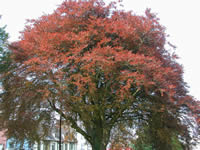
Many of the trees of this list have survived to the present day, and thanks to W Samuels we not only know the date they were growing but we can also get a rough date of planting .The church was completed on the 10.10 1848, and opened by the exotic tree enthusiast Lord Bishop Thirwell, of the Bishops Palace Abergwili (now the Carmarthen Museum).
What is interesting about the list is how many tree species have had a scientific and common name change since 1868. "Pyrus aucuparia for instance it is now called Sorbus aucuparia, and the Arucaria imbricata is now Araucaria araucana and what we now call the "Monkey puzzle tree was originally called a "Puzzle monkey tree" because, so the saying goes, "it would puzzle a monkey to climb it.
The Roots of the matter
I have been very fortunate to have been asked to conduct walks and talks on some of the woods and trees mentioned above, and it is has always been a pleasure to do so. There is much to add to this leafy tale ,and if anybody knows of any interesting, remarkable or sizable tree(s) for its (their) species, please let me know and I can forward the details to the "Tree Register of the British Isles" for whom I am a recorder.
What I do already know however, is even today we still seek our refuge and solace amongst the groves, coppices and forests of our landscape as our ancestors once did, and perhaps in doing so, we are unconsciously answering a call from our more deeper instincts, leading us back to our distant origins in the wild woods of old.
Bibliography
- W Samuel, Llandilo, Present and Past, published by Morgan and Davies, Welshman printing office. 1868
- Davies, William, Llandeilo-Fawr and its neighborhood, Printed by D.W.&G. Jones, Rhosmaen Street. 1858
- Linnard, William, Welsh Woods and forests, A History, published by Gomer, in 2000
- Hughes Lynn, A Carmarthen Anthology, published by Dinefwr Publishers, Llandybie, 2002
- Rackham, Oliver, The last forest, Published by Dent, in 1993
- Lewis Anne, BA, The last siege of Dryslwyn Castle
- The Tree Register of the British Isles
Footnotes
- W Samuel, "Llandilo, Present and Past, page 3, published by Morgan and Davies, "Welshman" printing office, 1868.
About the author
As well as being an authority on trees, Greg is an experienced professional genealogist and a qualified local historian. Based in Llandeilo, Greg runs the family history and genealogical research company The Time Machine with his wife Jayne, helping people trace their roots and family heritage.